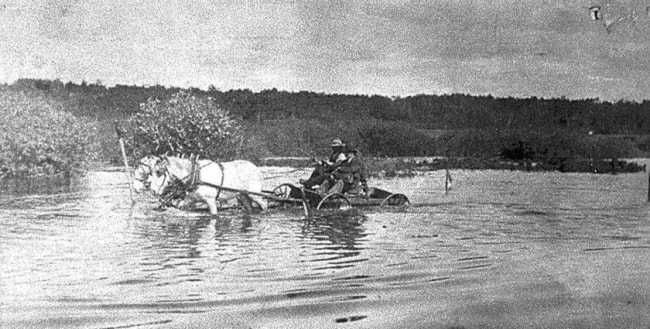For those of us who have lived in and around Ponoka for many years we will fondly look upon the Battle River as a lazy and quiet stream that flows quietly through our Town and County, hardly making a ripple during the summer and fall, and freezing solid in the winter. Then again, many of us will remember that our favourite home-town river has occasionally turned into a raging flood or a mighty rolling ice-jam before going back into its usual casual tranquility. If that old river could talk it would tell an amazing story of the colorful and exciting role that it has played in the creation of Ponoka for as far back as our history books have been written.
When famed British explorer and cartographer David Thompson ventured into the Central Alberta regions while mapping his way to the Rocky Mountains and the Pacific in 1800, he likely followed the native trails and camped along the Battle River. In the early 1880’s the rugged C and E trail had become the major trade route between Edmonton and Calgary, going through Ponoka, crossing the Battle River where today’s footbridge is now located, then proceeded past where the Provincial Mental Hospital was built in 1912. Stagecoaches made the first 300 kilometre trip from Edmonton to Calgary in three days, delivering passengers and mail, while heavy ox-drawn freight wagons made the trek in about a week. The longstanding C & E trail would later become one of Alberta’s first paved asphalt highways, which due to heavy traffic demand was then replaced by the construction of Highway 2A through Ponoka in the 1940’s, and later by the present QE from Edmonton to Calgary. Occasionally the Battle River would flood its banks, washing out the road and requiring lengthy repairs and re-routing. Early settlers brought in valuable furs and obtained supplies from the Hudson’s Bay Company trading post on the north bank of the river, just southwest of today’s industrial park. It was at this same location in 1885 during the tense days of the Riel Rebellion that the post was hastily fortified by the North West Mounted Police, 2 establishing a 20-man detachment at Fort Ostell, which fortunately never saw battle.
During the construction of the Edmonton to Calgary Railway in the late 1880’s the big work crews would camp along the Battle River, enjoying swimming and recreation in their spare time. The arrival of the Canadian Pacific Railway in 1891 reduced the arduous north/south trip to a mere 12 hours. Here in Ponoka our first classic train depot (Siding 14) was built, and included a palatial waiting room, areas to house the Station Agent and staff, and a long wooden platform to welcome and accommodate several noisy passenger and freight trains each day. Down at the Battle River below the tracks the C.P.R. dam was built to create a reservoir from which a windmill pumped water up into a wooden tower by the tracks to feed into the massive locomotives, and to occasionally assist the local Fire Department. The dam, which still partially remains 112 years later, also acted as a spillway for the many thousands of logs that were floated down to the three busy saw mills which were located just downstream, and served the ongoing ‘building boom’ in the urban and rural areas. This area was always extremely popular for a refreshing summer swim, picnic, or stroll, was teeming with jackfish and suckers for the avid angler, which were also hauled away by the truckload for sale or to feed livestock. Many tales have been told of romantic boat-rides in raft, canoe, or blow up dinghy along the Battle River, maybe even stopping to try and hook a big one, or pulling into shore for a weenie or marshmallow roast.
Throughout the years the rolling land along the banks of the Battle River would always be blessed with countless birds and wild-life, including the majestic Blue Heron, geese, ducks, fox, coyotes, deer, moose, beaver, and on and on. In the 1930s and 1940’s as the Town of Ponoka and surrounding districts grew at a rapid pace friendly Indian tribes would set up their tents in the river valley and come into town to shop, trade, and perform a colorful powwow and dance for local families A nice sandy area beside the river just a few moments from down-town was often utilized for massive church baptisms, a little ‘skinny dipping’ in the summer, and as a neat place to light a campfire and go skating in the winter.
Our local history books and old newspapers show and tell us of the devastating floods that occurred along the Battle River in 1912, 1948, and in the 1980’s, causing a great deal of damage, washing out the railway tracks and bridges, making travel impossible except for the trusty horse and wagon, and requiring everyone to pull together to survive the rising waters. Over the years several impending ice-jams during spring melt had to be broken up or dynamited by our local fire department, then in later years our unpredictable old Battle was rechanneled to slow down the flow from heavy rains and spring melt.
Whatever fond memories and good fun we have had in and around the Battle River over the years, we have certainly learned to respect her peaceful wandering beauty and her occasional playful and frisky ways and moods to get our attention.
